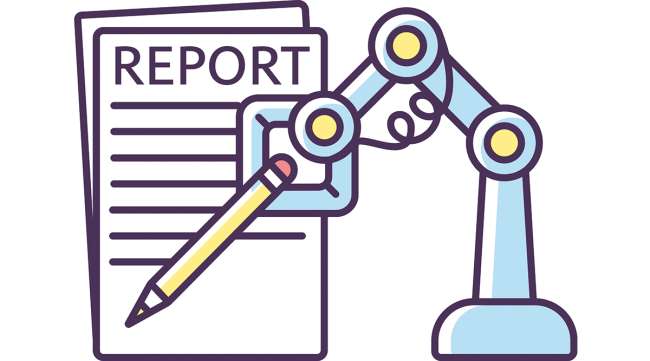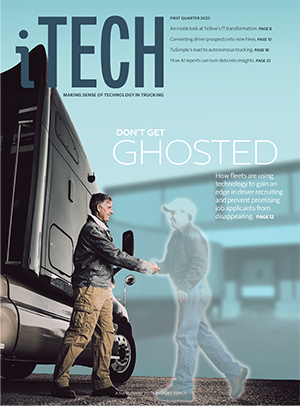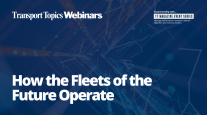Auto-Written Trend Reports: Fleet Insights in Clear Words

[Find the latest in trucking technology: Explore this quarter's issue of iTECH]
Transportation workers stumped by company charts and graphs that make no sense to them can take heart: Artificial intelligence software can automatically produce company reports in written form — and it doesn’t need to break the bank.
A new, dirt-cheap AI software tool from Microsoft enables you to trigger a text explanation of a chart or graph with just one mouse click. It also strings together text explanations of multiple charts and graphs tracking your company’s performance to create a short, written report that is completely and automatically written by your computer.
Dubbed “Smart Narratives” — referencing the ability to instantly autogenerate narratives or written explanations of charts, graphs and the like — the tool is included with the latest version of Microsoft Power BI, Microsoft’s business analytics software.

Dysart
The tool also is emblematic of a number of software solutions growing in popularity at businesses. Those solutions are also using AI-generated writing to explain what is going on in a chart or graph. Or, they are bypassing business visuals altogether and autowriting text-based company reports — which virtually are devoid of complicated chart-and-graph visuals.
Kirk Hay, chief information officer at auto hauler Jack Cooper Transport, said his firm is using AI software to automatically generate written company reports, which are autodistributed across a number of departments at the company.
Hay said the reason Jack Cooper switched to autowritten reports was for clarity and speed. Text-based reports often help key company decision-makers to identify changing trends in the market more quickly, enabling the company to be informed and more nimble, he said.
“Using automation intelligently is key to improvement,” Hay said.
Jack Cooper Holdings, based in Kennesaw, Ga., ranks No. 68 on the Transport Topics Top 100 list of the largest for-hire carriers in North America.
Covenant is another motor carrier that sees inherent value in switching to autowritten company reports.
“When you compare the accessibility of data — in relation to the speed in which logistics and trucking change — it could be argued that automated trend reports are one of the biggest ways to ‘see’ the changes coming without overburdening resources,” said Ashley Brown, senior director of continuous improvement and driver orientation at Covenant.
“In logistics, time is literally of the essence,” Brown added. “When you are shortening the time it takes to comb through data and assemble a report, you’re quickening the window in which impactful decisions can be made.”
Covenant Logistics Group, based in Chattanooga, Tenn., ranks No. 46 on the for-hire TT100.

Learn about real-world adoption strategies for self-driving trucks with Robert Brown of Spartan Radar and Charlie Jatt of Waymo. Hear a snippet above, and get the full program by going to RoadSigns.TTNews.com.
Julie Decker, project and development manager at Paper Transport, said the transportation industry involves “extreme amounts of data that can be used for analysis and delivering insights for business decision-making.”
Automating that process and delivering the resulting analysis in an easy-to-understand written format could prove valuable for many trucking firms, Decker said.
But perhaps the most promising facet of autogenerated company reports is that the AI technology underpinning the writing is poised to become ever-more sophisticated.
“In 10 years, we’ll look back on this state of AI-generated writing and see it as ‘ancient history,’ ” said Tom Weinandy, a digital economist and artificial intelligence programmer at IT consulting firm BlueGranite.
Meanwhile, back in the here and now, there are many reasons why truckers should be fascinated by Microsoft’s foray into autogenerated text explanations of charts and graphs. One of Smart Narratives’ biggest draws is that it is intuitive to use. For example: If you’re looking at a chart in Power BI you don’t understand, one mouse click on the chart brings up a pop-up text box that explains what’s going on, according to Ancy Philip, an AI specialist at Microsoft.
Until recently, autogenerating written company reports from raw data would cost big bucks. But as with most things tech, the price has dropped dramatically. These days, a subscription to Microsoft Power BI, which includes Smart Narratives, goes for as low as $20 a month per seat.
Generally, the companies that pioneered this approach to autoreport writing use a “report template” to autogenerate their reports. These templates work on the same principle as the old Mad Libs game you probably played in grammar school. Back in those days, Mad Labs furnished you a template story — say, how pizza was invented. You asked your friends for random nouns, verbs and adjectives to plug into blanks that were deliberately left in the story template.
Autoreport templates work the same way. They use the skeleton of a story — such as a daily sales report featuring blanks that are left to be filled with updates on your latest sales numbers, sales computations and the like. And then they autopopulate the skeleton template with the latest sales data, which tells the new story on company sales for the current day.
More Q1 iTECH
►How Fleets Are Winning the Race to Hire Drivers
►Clevenger: High-Tech Recruiting Battles
►TuSimple CEO Cheng Lu Outlines Vision for Autonomous Trucking
►Q&A: Yellow's Jason Ringgenberg
Explore the Issue!
The big difference with the new Smart Narratives tool in Microsoft Power BI — compared with many other AI-generated writing software solutions — is that Microsoft’s software still generates a chart or graph depicting changes and analysis of sales over a certain time period. But then it goes on to enable users to autogenerate a written analysis of that chart or graph with a mouse click.
It’s a clever move in that it preserves the importance of the charts, graphs and similar illustrations that Microsoft Power BI creates — the bread-and-butter of the analytics program, really — while offering graphics-averse users plain English descriptions of what the charts and graphs say.
In short, Smart Narratives and similar AI-generated writing software tools can be a game-changer for companies that use business analytics software such as Microsoft Power BI. That’s especially true given that you don’t need to write the templates needed to explain charts and graphics that are commonly used in Microsoft Power BI. Microsoft already has done it for you, off the shelf.
Yet another powerful feature of the Smart Narratives tool: its ability to simultaneously autogenerate text explanations of multiple charts and graphs. That’s a capability that will prove especially handy for users who have programmed Power BI to open up to a dashboard that tracks several different kinds of charts and graphs on company performance at the same time.
Once users get comfortable with the Smart Narratives tool, yet another powerful feature they find is that they can customize the style of writing that Smart Narratives uses to autogenerate plain English explanations of charts and graphs.
This capability — in the hands of a professional writer — can in no uncertain terms be a game-changer in its own right.
Want more news? Listen to today's daily briefing above or go here for more info
The plain, bare-bones text descriptions of charts and graphs that Smart Narratives offers do get the job done. But punch up that writing style with some sparkle and wit from a pro writer, and you’ll find that the text reports generated by Smart Narratives will grab a worker’s attention much more forcefully, hold on to it longer and better ensure that the key insights stay top of mind for your employees.
It wouldn’t be the best use of resources to task your graphics pro to improve the writing that you find in Smart Narratives — unless that person also happens to be a crack writer. Instead, hire or task a pro writer who can work with your business analytics people to truly make the AI-generated templates behind your autogenerated reports sing. Put another way: You wouldn’t hire Hemingway to paint the Sistine Chapel. And you wouldn’t hire Michelangelo to write “The Sun Also Rises.”
For transportation firms looking to get a taste of how autowritten reports can turbocharge the speed at which business analysis can be communicated and acted upon, Microsoft’s Smart Narratives tool is a great, extremely inexpensive place to start.
But over the long term, businesses also will want to take a look at similar AI autoreport writing tools offered by pioneers in the field, including Arria NLG, AX Semantics, Yseop, Narrative Science, Automated Insights, Narrativa, United Robots and vPhrase.
These companies have been working at commercialized AI-generated writing much longer than Microsoft, and they may have solutions more suited to your trucking organization — including AI-generated writing add-ins of their solutions that work with a number of business intelligence programs, including Microstrategy, Alik, Spotfire, SAP and Tableau, as well as Microsoft Power BI.
Joe Dysart is an internet speaker and business consultant based in Manhattan. Voice: (631) 438-1142. Email: joe@gurutechalert.com





